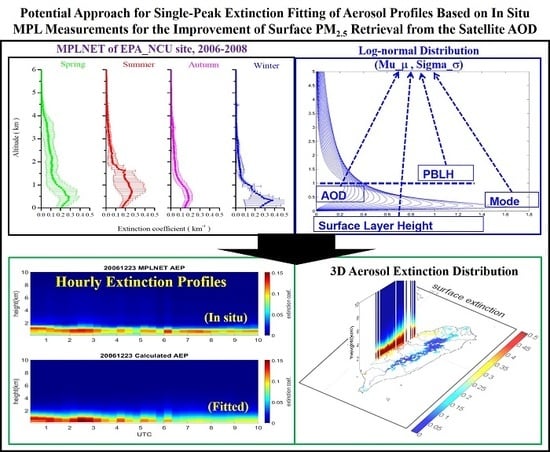Potential Approach for Single-Peak Extinction Fitting of Aerosol Profiles Based on In Situ Measurements for the Improvement of Surface PM2.5 Retrieval from Satellite AOD Product
Abstract
:1. Introduction
2. Materials and Methods
2.1. Data Sets
2.1.1. In Situ Measurements
2.1.2. MODIS AOD
2.1.3. GEOS-5 FP PBLH
2.2. Fitting Approach
2.2.1. Log-Normal Distribution
2.2.2. Fitting Procedure for the Single-Peak Extinction Profile
3. Results and Analyses
3.1. Impacts of AOD and PBLH on the Extinction Profile
3.2. Log-Normal Distribution in Terms of the AOD and PBLH
3.3. Scale Adjustment for Seasonal Variation (S)
3.4. Identifying the Height of the Surface Layer
3.5. Validation and Application of a Case Study
4. Discussion
5. Conclusions
Author Contributions
Funding
Acknowledgments
Conflicts of Interest
References
- Akimoto, H. Global air quality and pollution. Science 2003, 302, 1716–1719. [Google Scholar] [CrossRef] [Green Version]
- Pöschl, U. Atmospheric aerosols: Composition, transformation, climate and health effects. Angew. Chem Int. Ed. 2005, 44, 7520–7540. [Google Scholar] [CrossRef] [PubMed]
- Stocker, T.F.; Qin, D.; Plattner, G.-K.; Tignor, M.; Allen, S.K.; Boschung, J.; Nauels, A.; Xia, Y.; Bex, V.; Midgley, P.M. Climate Change 2013: The Physical Science Basis. Contribution of Working Group I to the Fifth Assessment Report of the Intergovernmental Panel on Climate Change; Cambrige University Press: New York, NY, USA, 2013. [Google Scholar] [CrossRef]
- Wu, G.; Li, Z.; Fu, C.; Zhang, X.; Zhang, R.; Zhang, R.; Zhou, D. Advances in studying interactions between aerosols and monsoon in China. Sci. China Earth Sci. 2016, 59, 1–16. [Google Scholar] [CrossRef]
- Caiazzo, F.; Ashok, A.; Waitz, I.A.; Yim, S.H.; Barrett, S.R. Air pollution and early deaths in the United States. Part I: Quantifying the impact of major sectors in 2005. Atmos. Environ. 2013, 79, 198–208. [Google Scholar] [CrossRef]
- Li, C.; Mao, J.; Lau, A.K.; Yuan, Z.; Wang, M.; Liu, X. Application of MODIS satellite products to the air pollution research in Beijing. Sci. China Ser. D Earth Sci. 2005, 48, 209–219. [Google Scholar] [CrossRef]
- Sacks, J.D.; Stanek, L.W.; Luben, T.J.; Johns, D.O.; Buckley, B.J.; Brown, J.S.; Ross, M. Particulate matter–induced health effects: Who is susceptible? Environ. Health Perspect. 2011, 119, 446. [Google Scholar] [CrossRef]
- Owili, P.O.; Lien, W.-H.; Muga, M.A.; Lin, T.-H. The associations between types of ambient PM2.5 and under-five and maternal mortality in Africa. Int. J. Environ. Res. Public Health 2017, 14, 359. [Google Scholar] [CrossRef] [PubMed] [Green Version]
- Lien, W.-H.; Owili, P.O.; Muga, M.A.; Lin, T.-H. Ambient particulate matter exposure and under-five and maternal deaths in Asia. Int. J. Environ. Res. Public Health 2019, 16, 3855. [Google Scholar] [CrossRef] [Green Version]
- Zhang, G.; Rui, X.; Fan, Y. Critical review of methods to estimate PM2. 5 concentrations within specified research region. ISPRS Int. J. Geo Inf. 2018, 7, 368. [Google Scholar] [CrossRef] [Green Version]
- Chu, D.A.; Kaufman, Y.; Zibordi, G.; Chern, J.; Mao, J.; Li, C.; Holben, B. Global monitoring of air pollution over land from the Earth Observing System-Terra Moderate Resolution Imaging Spectroradiometer (MODIS). J. Geophys. Res. Atmos. 2003, 108, 4661. [Google Scholar] [CrossRef]
- Wang, J.; Christopher, S.A. Intercomparison between satellite-derived aerosol optical thickness and PM2.5 mass: Implications for air quality studies. Geophys. Res. Lett. 2003, 30, 2095. [Google Scholar] [CrossRef]
- Engel-Cox, J.A.; Hoff, R.M.; Rogers, R.; Dimmick, F.; Rush, A.C.; Szykman, J.J.; Al-Saadi, J.; Chu, D.A.; Zell, E.R. Integrating lidar and satellite optical depth with ambient monitoring for 3-dimensional particulate characterization. Atmos. Environ. 2006, 40, 8056–8067. [Google Scholar] [CrossRef]
- Koelemeijer, R.; Homan, C.; Matthijsen, J. Comparison of spatial and temporal variations of aerosol optical thickness and particulate matter over Europe. Atmos. Environ. 2006, 40, 5304–5315. [Google Scholar] [CrossRef]
- Di Nicolantonio, W.; Cacciari, A.; Tomasi, C. Particulate matter at surface: Northern Italy monitoring based on satellite remote sensing, meteorological fields, and in-situ samplings. IEEE J. Sel. Top. Appl. Earth Obs. Remote Sens. 2009, 2, 284–292. [Google Scholar] [CrossRef]
- Tsai, T.-C.; Jeng, Y.-J.; Chu, D.A.; Chen, J.-P.; Chang, S.-C. Analysis of the relationship between MODIS aerosol optical depth and particulate matter from 2006 to 2008. Atmos. Environ. 2011, 45, 4777–4788. [Google Scholar] [CrossRef]
- Chu, D.A.; Tsai, T.-C.; Chen, J.-P.; Chang, S.-C.; Jeng, Y.-J.; Chiang, W.-L.; Lin, N.-H. Interpreting aerosol lidar profiles to better estimate surface PM2. 5 for columnar AOD measurements. Atmos. Environ. 2013, 79, 172–187. [Google Scholar] [CrossRef]
- Yap, X.; Hashim, M. A robust calibration approach for PM10 prediction from MODIS aerosol optical depth. Atmos. Chem. Phys. Dis. 2013, 13, 3517–3526. [Google Scholar] [CrossRef] [Green Version]
- Bilal, M.; Nichol, J.E.; Spak, S.N. A new approach for estimation of fine particulate concentrations using satellite aerosol optical depth and binning of meteorological variables. Aerosol Air Qual. Res. 2017, 11, 356–367. [Google Scholar] [CrossRef] [Green Version]
- Stafoggia, M.; Bellander, T.; Bucci, S.; Davoli, M.; de Hoogh, K.; De’Donato, F.; Gariazzo, C.; Lyapustin, A.; Michelozzi, P.; Renzi, M.; et al. Estimation of daily PM10 and PM2.5 concentrations in Italy, 2013–2015, using a spatiotemporal land-use random-forest model. Environ. Int. 2019, 124, 170–179. [Google Scholar] [CrossRef]
- Xue, T.; Zheng, Y.; Tong, D.; Zheng, B.; Li, X.; Zhu, T.; Zhang, Q. Spatiotemporal continuous estimates of PM2. 5 concentrations in China, 2000–2016: A machine learning method with inputs from satellites, chemical transport model, and ground observations. Environ. Int. 2019, 123, 345–357. [Google Scholar] [CrossRef]
- Chelani, A.B. Estimating PM2. 5 concentration from satellite derived aerosol optical depth and meteorological variables using a combination model. Atmos. Pollut. Res. 2019, 10, 847–857. [Google Scholar] [CrossRef]
- Zeydan, Ö.; Wang, Y. Using MODIS derived aerosol optical depth to estimate ground-level PM2. 5 concentrations over Turkey. Atmos. Pollut. Res. 2019, 10, 1565–1576. [Google Scholar] [CrossRef]
- Lee, H.J. Benefits of high resolution PM2. 5 prediction using satellite MAIAC AOD and land use regression for exposure assessment: California examples. Environ. Sci. Technol. 2019, 53, 12774–12783. [Google Scholar] [CrossRef] [PubMed]
- Van Donkelaar, A.; Martin, R.V.; Brauer, M.; Kahn, R.; Levy, R.; Verduzco, C.; Villeneuve, P.J. Global estimates of ambient fine particulate matter concentrations from satellite-based aerosol optical depth: Development and application. Environ. Health Perspect. 2010, 118, 847. [Google Scholar] [CrossRef] [PubMed] [Green Version]
- Li, J.; Carlson, B.E.; Lacis, A.A. How well do satellite AOD observations represent the spatial and temporal variability of PM2.5 concentration for the United States? Atmos. Environ. 2015, 102, 260–273. [Google Scholar] [CrossRef]
- Wang, Z.; Chen, L.; Tao, J.; Zhang, Y.; Su, L. Satellite-based estimation of regional particulate matter (PM) in Beijing using vertical-and-RH correcting method. Remote Sens. Environ. 2010, 114, 50–63. [Google Scholar] [CrossRef]
- Zheng, S.; Pozzer, A.; Cao, C.; Lelieveld, J. Long-term (2001–2012) concentrations of fine particulate matter (PM 2.5) and the impact on human health in Beijing. China. Atmos. Chem. Phys. 2015, 15, 5715–5725. [Google Scholar] [CrossRef] [Green Version]
- Lin, C.; Li, Y.; Yuan, Z.; Lau, A.K.; Li, C.; Fung, J.C. Using satellite remote sensing data to estimate the high-resolution distribution of ground-level PM2.5. Remote Sens. Environ. 2015, 156, 117–128. [Google Scholar] [CrossRef]
- Welton, E.J.; Campbell, J.R.; Spinhirne, J.D.; Scott, V.S. Global monitoring of clouds and aerosols using a network of micropulse lidar systems. In Proceedings of the Lidar Remote Sensing for Industry and Environment Monitoring, Sendai, Japan, 9–12 October 2000. [Google Scholar]
- Welton, E.J.; Stewart, S.A.; Lewis, J.R.; Belcher, L.R.; Campbell, J.R.; Lolli, S. Status of the NASA Micro Pulse Lidar Network (MPLNET): Overview of the network and future plans, new version 3 data products, and the polarized MPL. EPJ Web Conf. 2018, 176, 09003. [Google Scholar] [CrossRef] [Green Version]
- Engel-Cox, J.A.; Holloman, C.H.; Coutant, B.W.; Hoff, R.M. Qualitative and quantitative evaluation of MODIS satellite sensor data for regional and urban scale air quality. Atmos. Environ. 2004, 38, 2495–2509. [Google Scholar] [CrossRef]
- He, Q.; Li, C.; Mao, J.; Lau, A.K.H.; Chu, D. Analysis of aerosol vertical distribution and variability in Hong Kong. J. Geophys. Res. Atmos. 2008, 13, D14211. [Google Scholar] [CrossRef]
- Chen, Y.; Zhao, C.; Zhang, Q.; Deng, Z.; Huang, M.; Ma, X. Aircraft study of mountain chimney effect of Beijing, china. J. Geophys. Res. Atmos. 2009, 114, D08306. [Google Scholar] [CrossRef]
- Yongxiang, H.; Xiaomin, F.; Tianliang, Z.; Shichang, K. Long range trans-Pacific transport and deposition of Asian dust aerosols. J. Environ. Sci. 2008, 20, 424–428. [Google Scholar] [CrossRef]
- Holben, B.N.; Eck, T.F.; Slutsker, I.; Tanre, D.; Buis, J.; Setzer, A.; Vermote, E.; Reagan, J.; Kaufman, Y.; Nakajima, T.; et al. AERONET—A federated instrument network and data archive for aerosol characterization. Remote Sens. Environ. 1998, 66, 1–16. [Google Scholar] [CrossRef]
- Holben, B.; Tanre, D.; Smirnov, A.; Eck, T.; Slutsker, I.; Abuhassan, N.; Newcomb, W.W.; Schafer, J.S.; Chatenet, B.; Lavenu, F.; et al. An emerging ground-based aerosol climatology: Aerosol optical depth from AERONET. J. Geophys. Res. Atmos. 2001, 106, 12067–12097. [Google Scholar] [CrossRef]
- AERONET (AErosol RObotic NETwork). Available online: https://aeronet.gsfc.nasa.gov/ (accessed on 1 September 2016).
- Campbell, J.R.; Hlavka, D.L.; Welton, E.J.; Flynn, C.J.; Turner, D.D.; Spinhirne, J.D.; Scott, V.S.; Hwang, I.H. Full-time, eye-safe cloud and aerosol lidar observation at atmospheric radiation measurement program sites: Instruments and data processing. J. Atmos. Ocean. Technol. 2002, 19, 431–442. [Google Scholar] [CrossRef]
- Welton, E.J.; Voss, K.J.; Quinn, P.K.; Flatau, P.J.; Markowicz, K.; Campbell, J.R.; Spinhirne, J.D.; Gordon, H.R.; Johnson, J.E. Measurements of aerosol vertical profiles and optical properties during INDOEX 1999 using micro-pulse lidars. J. Geophys. Res. 2002, 107, 8019. [Google Scholar] [CrossRef]
- Welton, E.J.; Voss, K.J.; Gordon, H.R.; Maring, H.; Smirnov, A.; Holben, B.; Schmid, B.; Livingston, J.M.; Russell, P.B.; Durkee, P.A.; et al. Ground-based Lidar Measurements of Aerosols during ACE-2: Instrument Description, Results, and Comparisons with Other Ground-based and Airborne Measurements. Tellus B Chem. Phys. Meteorol. 2000, 52, 636–651. [Google Scholar] [CrossRef] [Green Version]
- Wang, S.-H.; Lin, N.-H.; Chou, M.-D.; Tsay, S.-C.; Welton, E.J.; Hsu, N.C.; Giles, D.M.; Liu, G.-R.; Holben, B.N. Profiling transboundary aerosols over Taiwan and assessing their radiative effects. J. Geophys. Res. 2010, 115. [Google Scholar] [CrossRef]
- Potter, T.D.; Colman, B.R. Handbook of Weather, Climate, and Water: Atmospheric Chemistry, Hydrology, and Societal Impacts; Wiley-Interscience: Hoboken, NJ, USA, 2003; ISBN 978-0471214892. [Google Scholar]
- Chiang, C.-W.; Chen, W.-N.; Liang, W.-A.; Das, S.K.; Nee, J.-B. Optical properties of tropospheric aerosols based on measurements of lidar, sun-photometer, and visibility at Chung-Li (25° N, 121° E). Atmos. Environ. 2007, 41, 4128–4137. [Google Scholar] [CrossRef]
- Level-1 and Atmosphere Archive & Distribution System, Distributed Active Archive Center (NASA). Available online: https://ladsweb.nascom.nasa.gov/ (accessed on 1 September 2016).
- Munchak, L.A.; Levy, R.C.; Mattoo, S.; Remer, L.A.; Holben, B.N.; Schafer, J.S.; Hostetler, C.A.; Ferrare, R.A. MODIS 3 km aerosol product: Applications over land in an urban/suburban region. Atmos. Meas. Tech. 2013, 6, 1747–1759. [Google Scholar] [CrossRef] [Green Version]
- The Global Modeling and Assimilation Office (GMAO). Available online: https://gmao.gsfc.nasa.gov/ (accessed on 1 September 2017).
- Heintzenberg, J. Properties of the log-normal particle size distribution. Aerosol Sci. Technol. 1994, 21, 46–48. [Google Scholar] [CrossRef]
- Otto, E.; Fissan, H.; Park, S.; Lee, K. The log-normal size distribution theory of Brownian aerosol coagulation for the entire particle size range: Part II—Analytical solution using Dahneke’s coagulation kernel. J. Aerosol Sci. 1999, 30, 17–34. [Google Scholar] [CrossRef]
- Park, S.; Lee, K.; Otto, E.; Fissan, H. The log-normal size distribution theory of Brownian aerosol coagulation for the entire particle size range: Part I—Analytical solution using the harmonic mean coagulation kernel. J. Aerosol Sci. 1999, 30, 3–16. [Google Scholar] [CrossRef]
- Xue, L.; Ding, A.; Gao, J.; Wang, T.; Wang, W.; Wang, X.; Lei, H.; Jin, D.; Qi, Y. Aircraft measurements of the vertical distribution of sulfur dioxide and aerosol scattering coefficient in China. Atmos. Environ. 2010, 44, 278–282. [Google Scholar] [CrossRef]
- Sanghavi, S.; Martonchik, J.; Landgraf, J.; Platt, U. Retrieval of aerosol optical depth and vertical distribution using O2 A- and B-band SCIAMACHY observations over Kanpur: A case study. Atmos. Meas. Tech. Dis. 2011, 4, 6779–6809. [Google Scholar] [CrossRef]
- Hollstein, A.; Filipitsch, F. Global representation of aerosol vertical profiles by sums of lognormal modes: Consequences for the passive remote sensing of aerosol heights. J. Geophys. Res. Atmos. 2014, 119, 8899–8907. [Google Scholar] [CrossRef]
- Quan, J.; Gao, Y.; Zhang, Q.; Tie, X.; Cao, J.; Han, S.; Zhao, D. Evolution of planetary boundary layer under different weather conditions, and its impact on aerosol concentrations. Particuology 2013, 11, 34–40. [Google Scholar] [CrossRef]

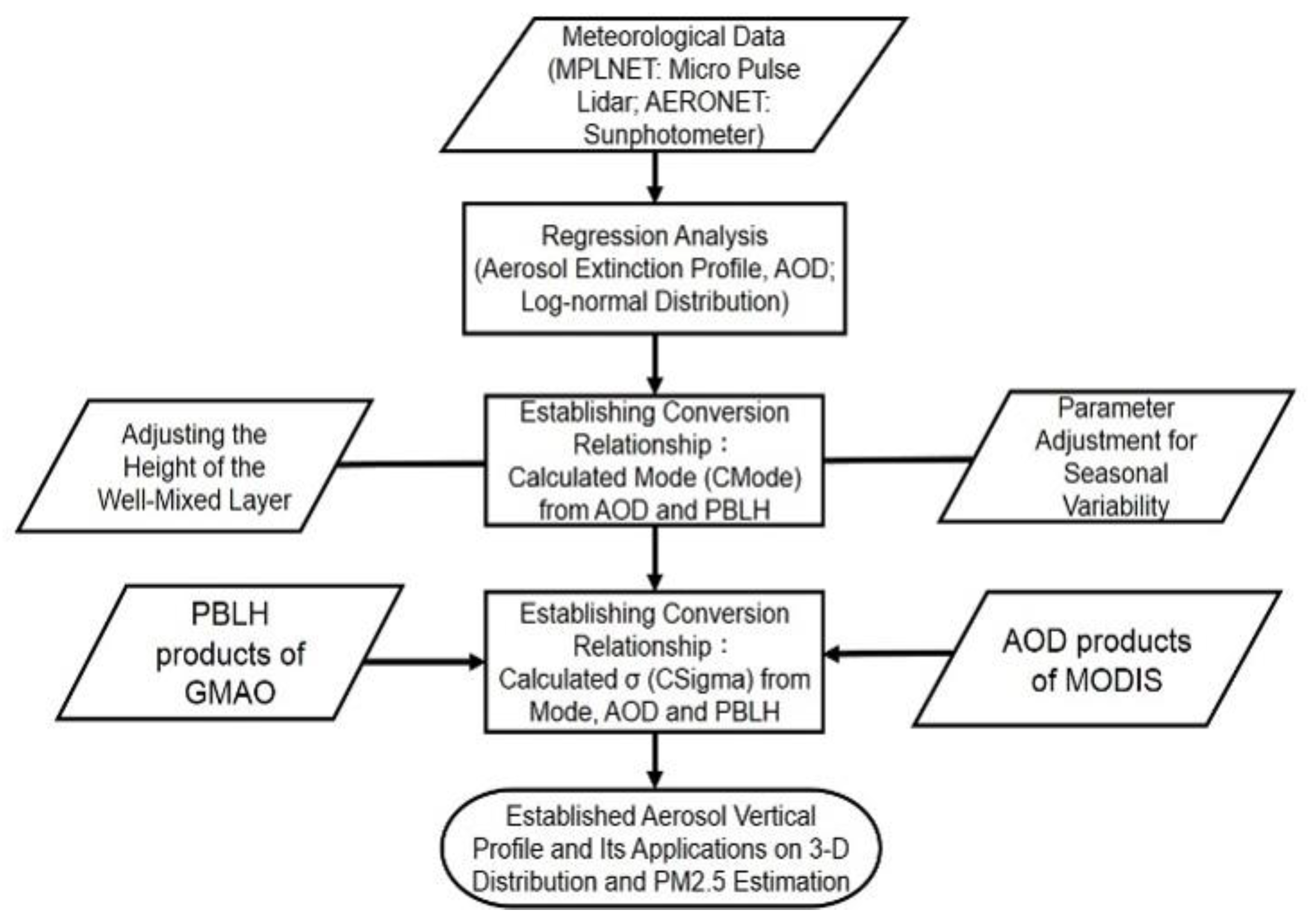
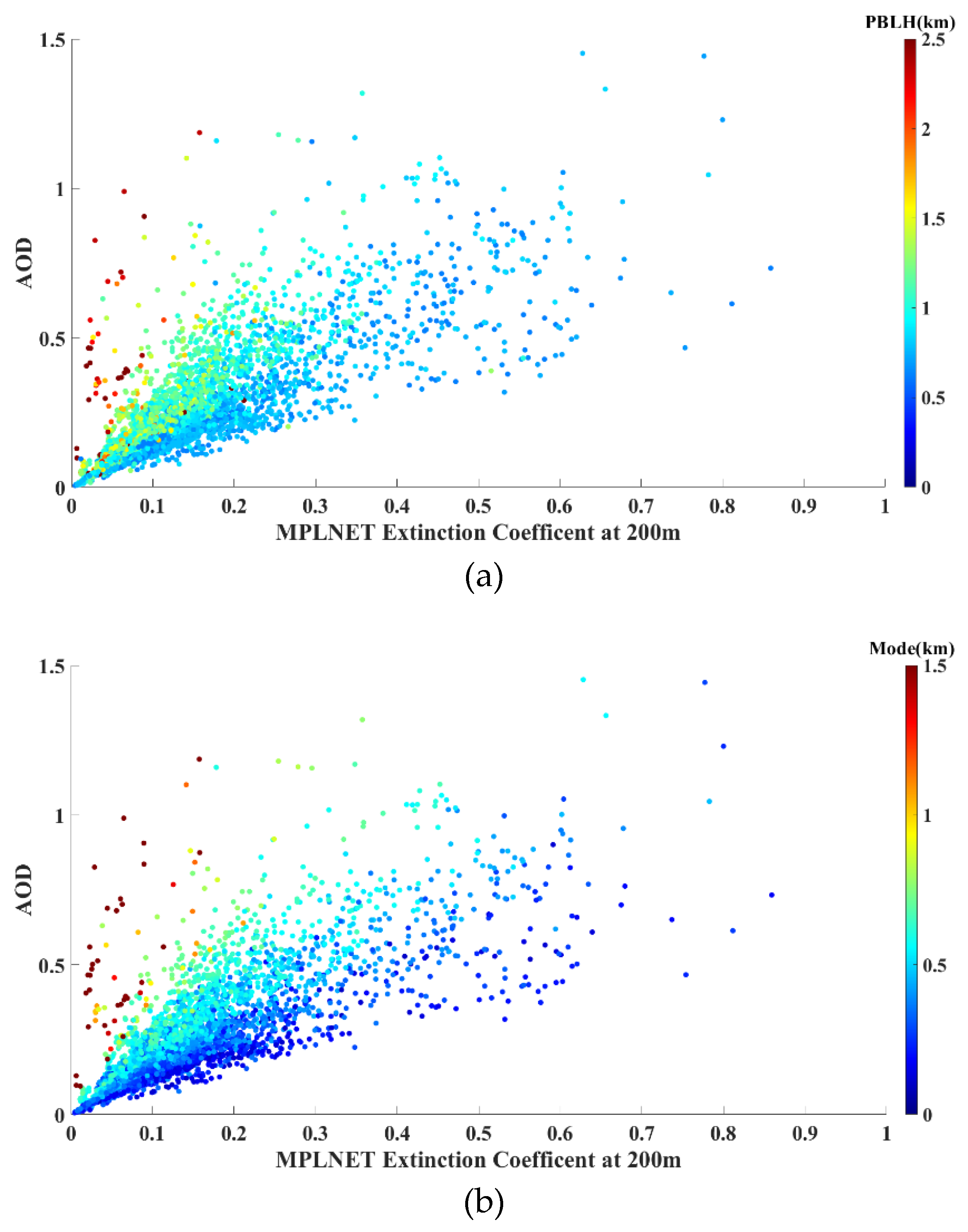

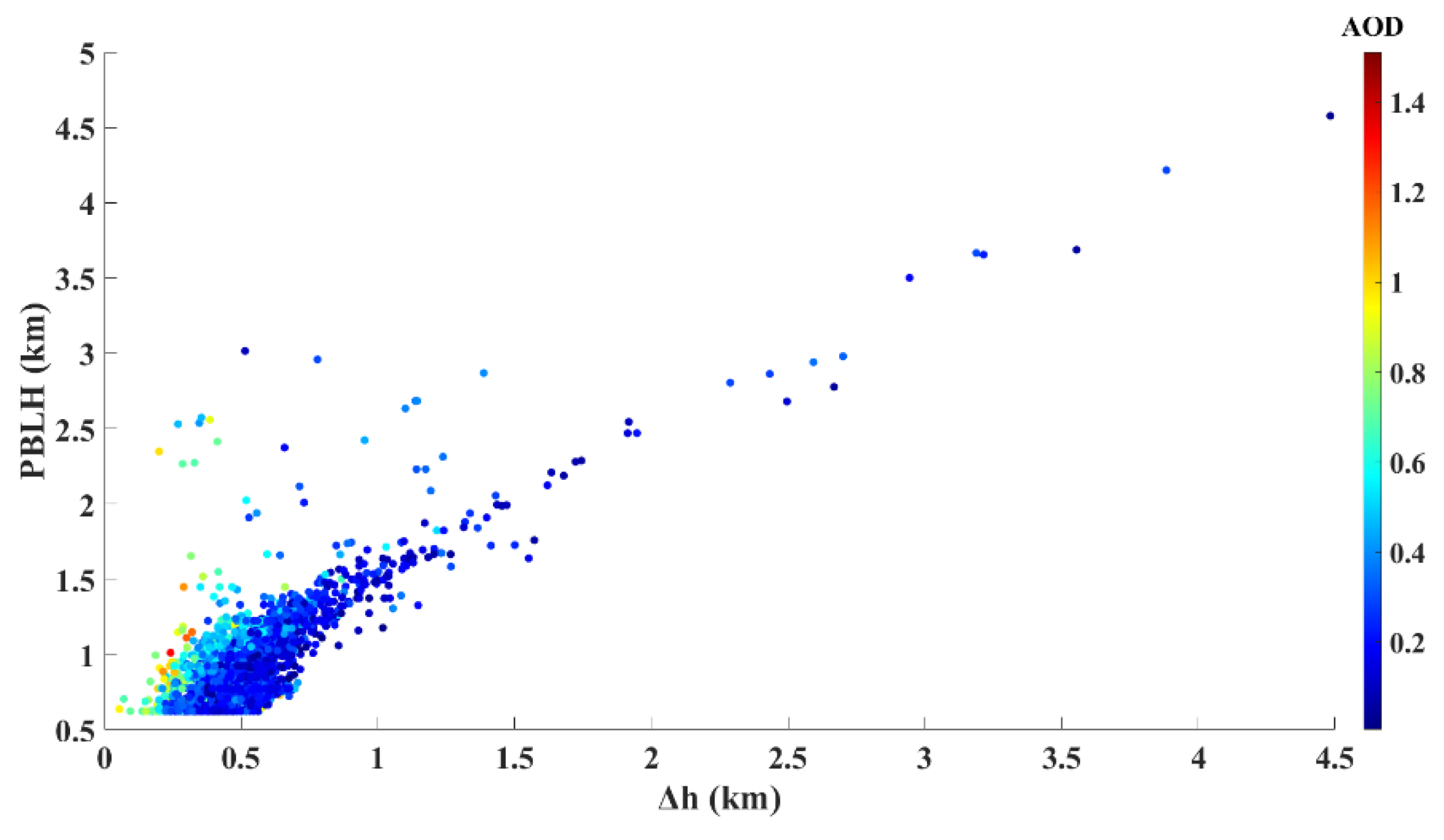
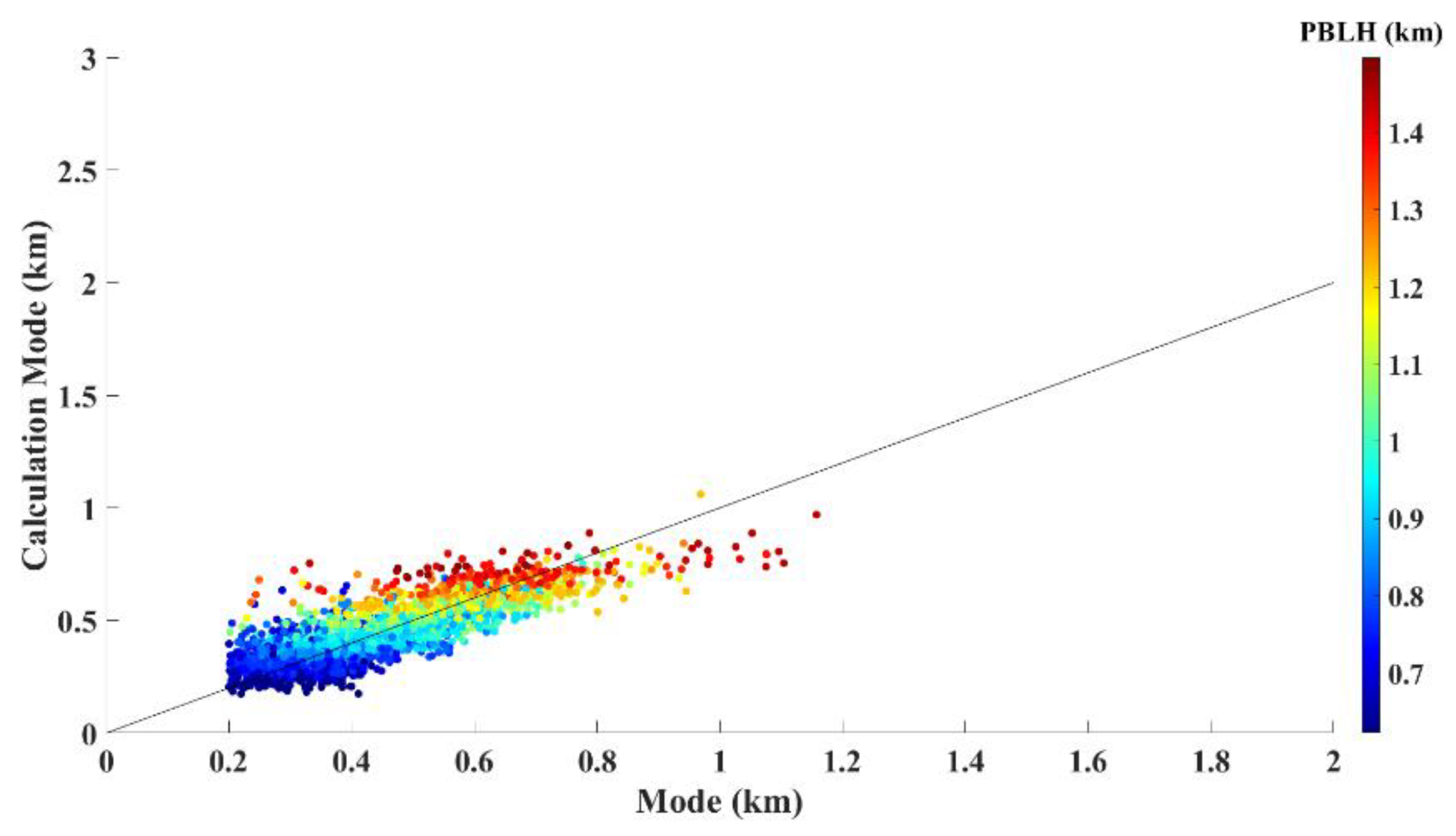
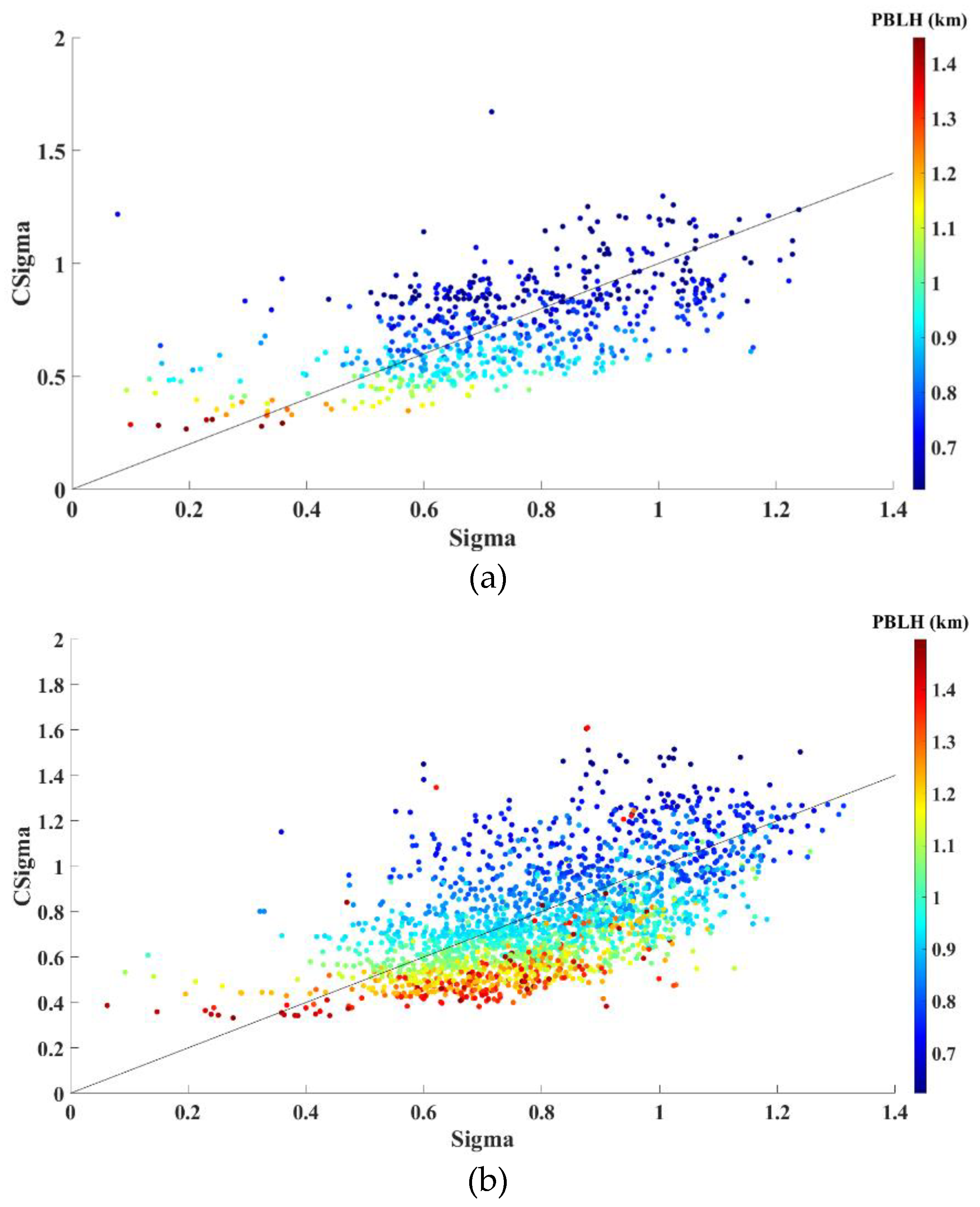
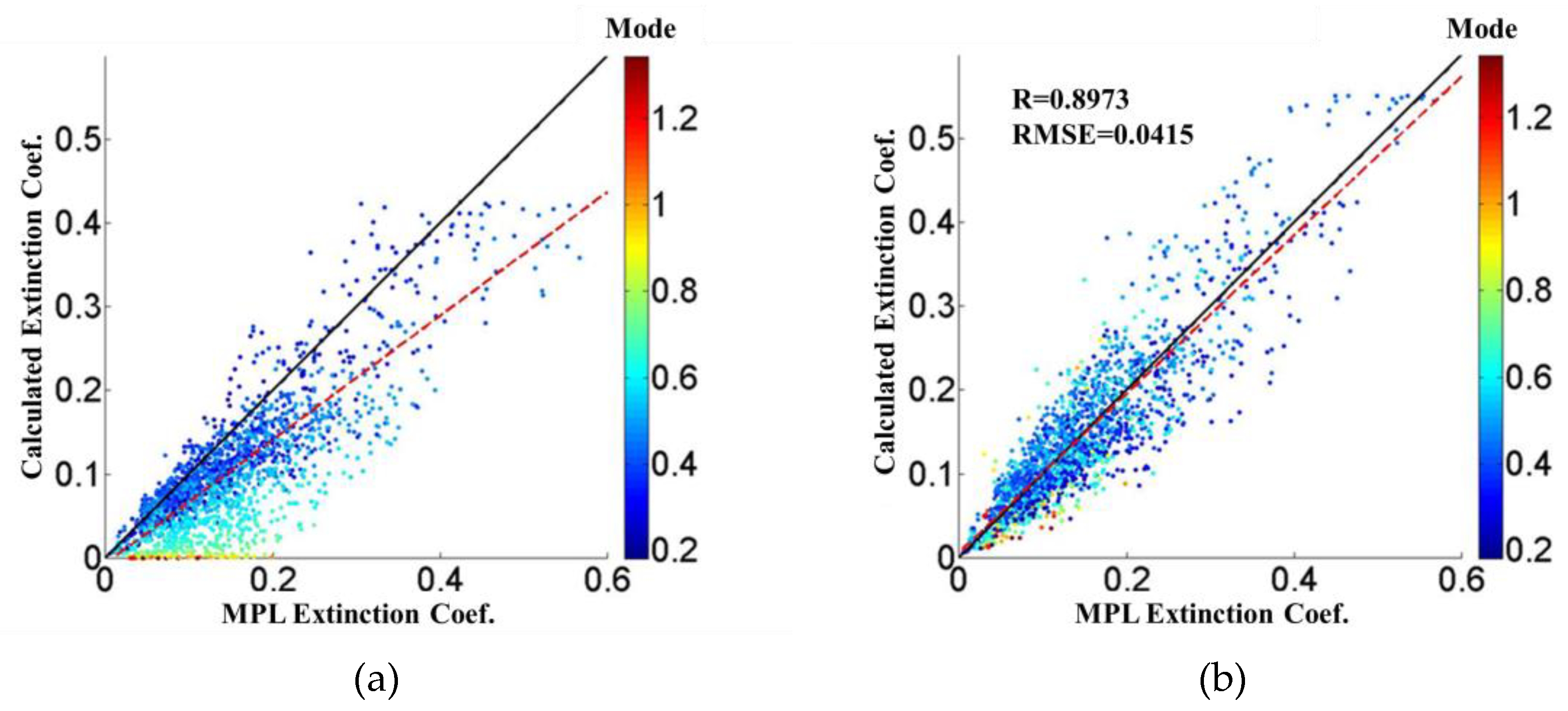


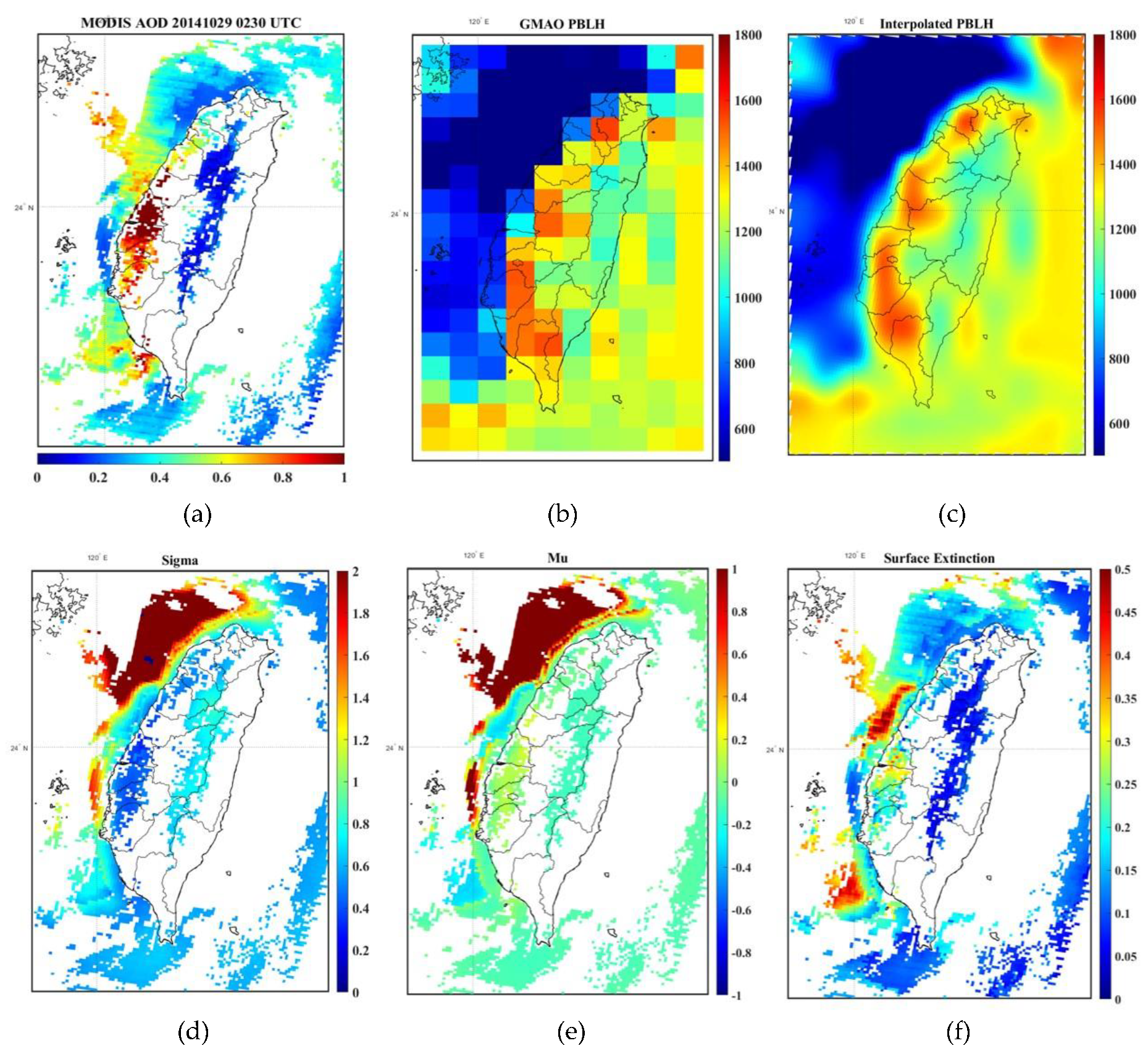

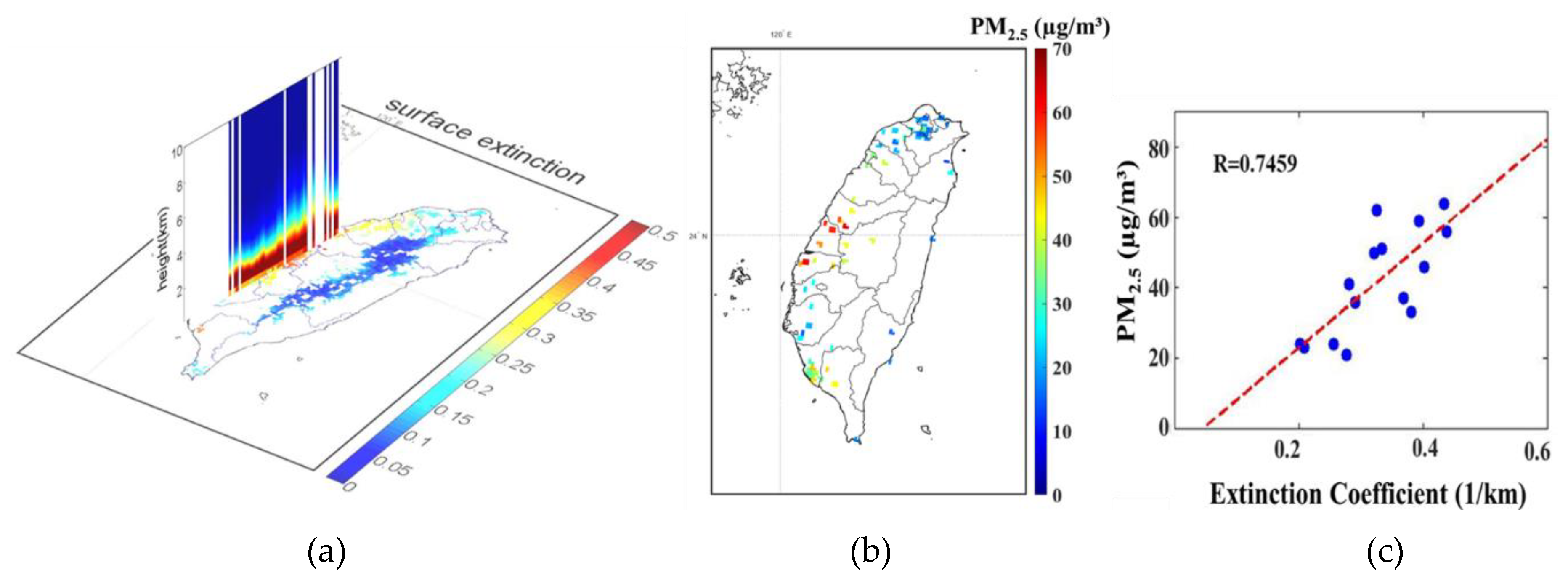
| AOD | Slope | Offset | R | RMSE | Data Point | Mean AOD | P-Value a |
|---|---|---|---|---|---|---|---|
| 0.00–0.05 | 1.037 | 0.3154 | 0.9984 | 0.1044 | 84 | 0.025 | <0.001 |
| 0.05–0.10 | 1.191 | 0.2303 | 0.9935 | 0.0334 | 286 | 0.075 | <0.001 |
| 0.10–0.15 | 1.110 | 0.2954 | 0.8217 | 0.1344 | 561 | 0.125 | <0.001 |
| 0.15–0.20 | 1.163 | 0.2762 | 0.9951 | 0.0232 | 594 | 0.175 | <0.001 |
| 0.20–0.25 | 1.163 | 0.3081 | 0.6815 | 0.1527 | 498 | 0.225 | <0.001 |
| 0.25–0.30 | 1.038 | 0.4288 | 0.9967 | 0.0246 | 343 | 0.275 | <0.001 |
| 0.30–0.35 | 1.279 | 0.3291 | 0.9908 | 0.0283 | 225 | 0.325 | <0.001 |
| 0.35–0.40 | 1.300 | 0.3376 | 0.9924 | 0.0361 | 180 | 0.375 | <0.001 |
| 0.40–0.45 | 1.139 | 0.4237 | 0.9796 | 0.0435 | 156 | 0.425 | <0.001 |
| 0.45–0.50 | 1.219 | 0.4372 | 0.9722 | 0.0452 | 136 | 0.475 | <0.001 |
| 0.50–0.55 | 1.137 | 0.4403 | 0.9736 | 0.0394 | 115 | 0.525 | <0.001 |
| 0.55–0.60 | 1.182 | 0.4554 | 0.9641 | 0.0531 | 70 | 0.575 | <0.001 |
| Δh | Slope | Offset | R | P-Value a |
|---|---|---|---|---|
| 0.00–0.20 | 17.115 | 1.3 | 0.756 | <0.001 |
| 0.20–0.25 | 13.863 | 1.3 | 0.840 | <0.001 |
| 0.25–0.30 | 11.251 | 1.3 | 0.792 | <0.001 |
| 0.30–0.35 | 9.7043 | 1.3 | 0.750 | <0.001 |
| 0.35–0.40 | 8.6445 | 1.3 | 0.684 | <0.001 |
| AOD | Slope | Offset | R | P-Value a |
|---|---|---|---|---|
| 0.30–0.35 | 8.277 | 2.5 | 0.2014 | <0.001 |
| 0.35–0.40 | 7.124 | 2.5 | 0.7593 | <0.001 |
| 0.40–0.45 | 6.148 | 2.5 | 0.8747 | <0.001 |
| 0.45–0.50 | 5.584 | 2.5 | 0.9064 | <0.001 |
| 0.50–0.55 | 5.486 | 2.5 | 0.9167 | <0.001 |
| 0.55–0.60 | 5.412 | 2.5 | 0.8908 | <0.001 |
| 0.60–0.65 | 4.336 | 2.5 | 0.933 | <0.001 |
| 0.65–0.70 | 4.129 | 2.5 | 0.9205 | <0.001 |
| 0.70–0.75 | 3.687 | 2.5 | 0.9673 | <0.001 |
| 0.75–0.80 | 3.590 | 2.5 | 0.9533 | <0.001 |
| 0.80–0.85 | 3.180 | 2.5 | 0.9818 | <0.001 |
| 0.85–0.90 | 2.954 | 2.5 | 0.9910 | <0.001 |
| 0.90–0.95 | 3.191 | 2.5 | 0.9671 | <0.001 |
| >0.95 | 3.425 | 2.5 | 0.6446 | <0.001 |
© 2020 by the authors. Licensee MDPI, Basel, Switzerland. This article is an open access article distributed under the terms and conditions of the Creative Commons Attribution (CC BY) license (http://creativecommons.org/licenses/by/4.0/).
Share and Cite
Lin, T.-H.; Chang, K.-E.; Chan, H.-P.; Hsiao, T.-C.; Lin, N.-H.; Chuang, M.-T.; Yeh, H.-Y. Potential Approach for Single-Peak Extinction Fitting of Aerosol Profiles Based on In Situ Measurements for the Improvement of Surface PM2.5 Retrieval from Satellite AOD Product. Remote Sens. 2020, 12, 2174. https://doi.org/10.3390/rs12132174
Lin T-H, Chang K-E, Chan H-P, Hsiao T-C, Lin N-H, Chuang M-T, Yeh H-Y. Potential Approach for Single-Peak Extinction Fitting of Aerosol Profiles Based on In Situ Measurements for the Improvement of Surface PM2.5 Retrieval from Satellite AOD Product. Remote Sensing. 2020; 12(13):2174. https://doi.org/10.3390/rs12132174
Chicago/Turabian StyleLin, Tang-Huang, Kuo-En Chang, Hai-Po Chan, Ta-Chih Hsiao, Neng-Huei Lin, Ming-Tung Chuang, and Hung-Yi Yeh. 2020. "Potential Approach for Single-Peak Extinction Fitting of Aerosol Profiles Based on In Situ Measurements for the Improvement of Surface PM2.5 Retrieval from Satellite AOD Product" Remote Sensing 12, no. 13: 2174. https://doi.org/10.3390/rs12132174
APA StyleLin, T.-H., Chang, K.-E., Chan, H.-P., Hsiao, T.-C., Lin, N.-H., Chuang, M.-T., & Yeh, H.-Y. (2020). Potential Approach for Single-Peak Extinction Fitting of Aerosol Profiles Based on In Situ Measurements for the Improvement of Surface PM2.5 Retrieval from Satellite AOD Product. Remote Sensing, 12(13), 2174. https://doi.org/10.3390/rs12132174







